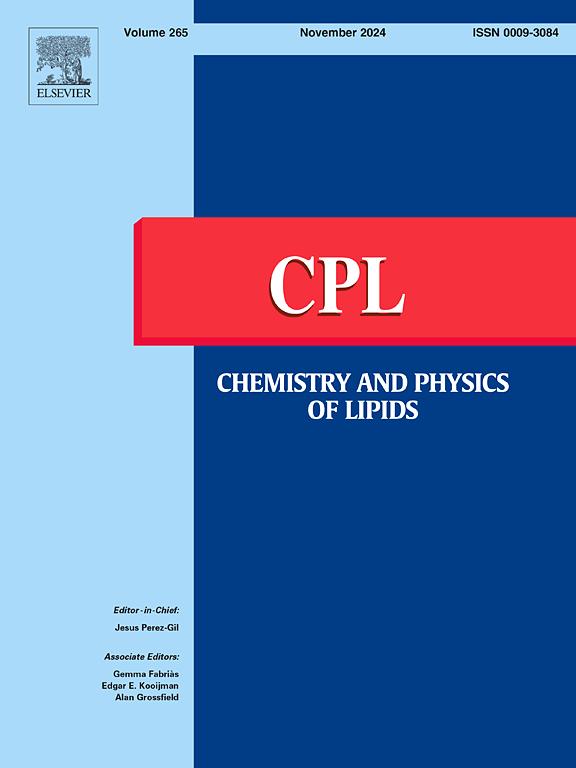Stabilization of milk-sphingomyelin gel phases by glycosphingolipids: An in-vitro study on the characteristics of milk sphingolipid gel phases
IF 2.8
3区 生物学
Q2 BIOCHEMISTRY & MOLECULAR BIOLOGY
引用次数: 0
Abstract
Sphingolipids constitute a class of bioactive lipids essential for the structural and functional integrity of milk fat globule membrane (MFGM). Milk sphingomyelin (milk-SM), as a key component of MFGM, contributes to the stability of milk fat emulsions. Milk-SM and other sphingolipids, like glycosphingolipids (GSL), coexist in the same outer bilayer of MFGM, suggesting significant role of their interaction in shaping the structural properties and functions of MFGM. In this study, using an in-vitro model membrane system, we investigated the impact of various GSLs, including cerebrosides and gangliosides, on the lateral segregation and phase behavior of milk-SM in 1-palmitoyl-2-oleoyl-sn-glycero-3-phosphocholine bilayers. We also incorporated N-palmitoyl-D-erythro-ceramide for a comparative analysis of the impacts of sphingolipid head groups. The lateral segregation of sphingolipid gel phases was assessed using trans-parinaric acid (tPA) fluorescence lifetime analysis, and their thermostability was examined using steady-state fluorescence anisotropy of tPA. Additionally, we assessed the binary interactions between milk-SM and GSLs using the steady-state fluorescence anisotropy of 1,6-diphenyl-1,3,5-hexatriene (DPH). The results indicate that GSLs promote the lateral segregation and stabilization of milk-SM-rich gel phases in the membrane bilayers. The size of the GSL head groups significantly influenced the degree of this stabilization, with larger head groups demonstrating diminished interactions with milk-SM. Our results provide valuable insights into the role of various sphingolipid structures in membrane phase behavior and organization. Comprehensive understanding of the interactions of these important sphingolipids in MFGM environment is crucial due to their structural and functional importance in dairy and nutritional applications.
鞘脂糖对乳鞘磷脂凝胶相的稳定作用:乳鞘脂凝胶相特性的体外研究。
鞘脂是一类生物活性脂类,对乳脂球膜的结构和功能完整性至关重要。乳鞘磷脂(Milk sphingomyelin, Milk - sm)作为MFGM的关键成分,对乳脂乳剂的稳定性起着重要作用。Milk-SM和鞘脂糖(GSL)等鞘脂共存于MFGM的同一外双分子层,表明它们的相互作用在MFGM的结构特性和功能形成中起着重要作用。在这项研究中,我们使用体外模型膜系统,研究了各种GSLs,包括脑苷和神经节苷,对乳sm在1-棕榈酰-2-油酰-sn-甘油-3-磷脂胆碱双层中的侧向分离和相行为的影响。我们还加入了n -棕榈酰- d -红-神经酰胺,对鞘脂头组的影响进行了比较分析。利用反式parinaric酸(tPA)荧光寿命分析评估鞘脂凝胶相的侧向分离,并利用tPA的稳态荧光各向异性检测其热稳定性。此外,我们利用1,6-二苯基-1,3,5-己三烯(DPH)的稳态荧光各向异性评估了牛奶- sm和GSLs之间的二元相互作用。结果表明,GSLs促进了膜双层中富乳- sm凝胶相的侧向分离和稳定。GSL头群的大小显著影响了这种稳定的程度,较大的头群显示出与牛奶sm的相互作用减弱。我们的结果为鞘脂结构在膜相行为和组织中的作用提供了有价值的见解。全面了解这些重要鞘脂在MFGM环境中的相互作用是至关重要的,因为它们在乳制品和营养应用中的结构和功能的重要性。
本文章由计算机程序翻译,如有差异,请以英文原文为准。
求助全文
约1分钟内获得全文
求助全文
来源期刊

Chemistry and Physics of Lipids
生物-生化与分子生物学
CiteScore
7.60
自引率
2.90%
发文量
50
审稿时长
40 days
期刊介绍:
Chemistry and Physics of Lipids publishes research papers and review articles on chemical and physical aspects of lipids with primary emphasis on the relationship of these properties to biological functions and to biomedical applications.
Accordingly, the journal covers: advances in synthetic and analytical lipid methodology; mass-spectrometry of lipids; chemical and physical characterisation of isolated structures; thermodynamics, phase behaviour, topology and dynamics of lipid assemblies; physicochemical studies into lipid-lipid and lipid-protein interactions in lipoproteins and in natural and model membranes; movement of lipids within, across and between membranes; intracellular lipid transfer; structure-function relationships and the nature of lipid-derived second messengers; chemical, physical and functional alterations of lipids induced by free radicals; enzymatic and non-enzymatic mechanisms of lipid peroxidation in cells, tissues, biofluids; oxidative lipidomics; and the role of lipids in the regulation of membrane-dependent biological processes.
 求助内容:
求助内容: 应助结果提醒方式:
应助结果提醒方式:


